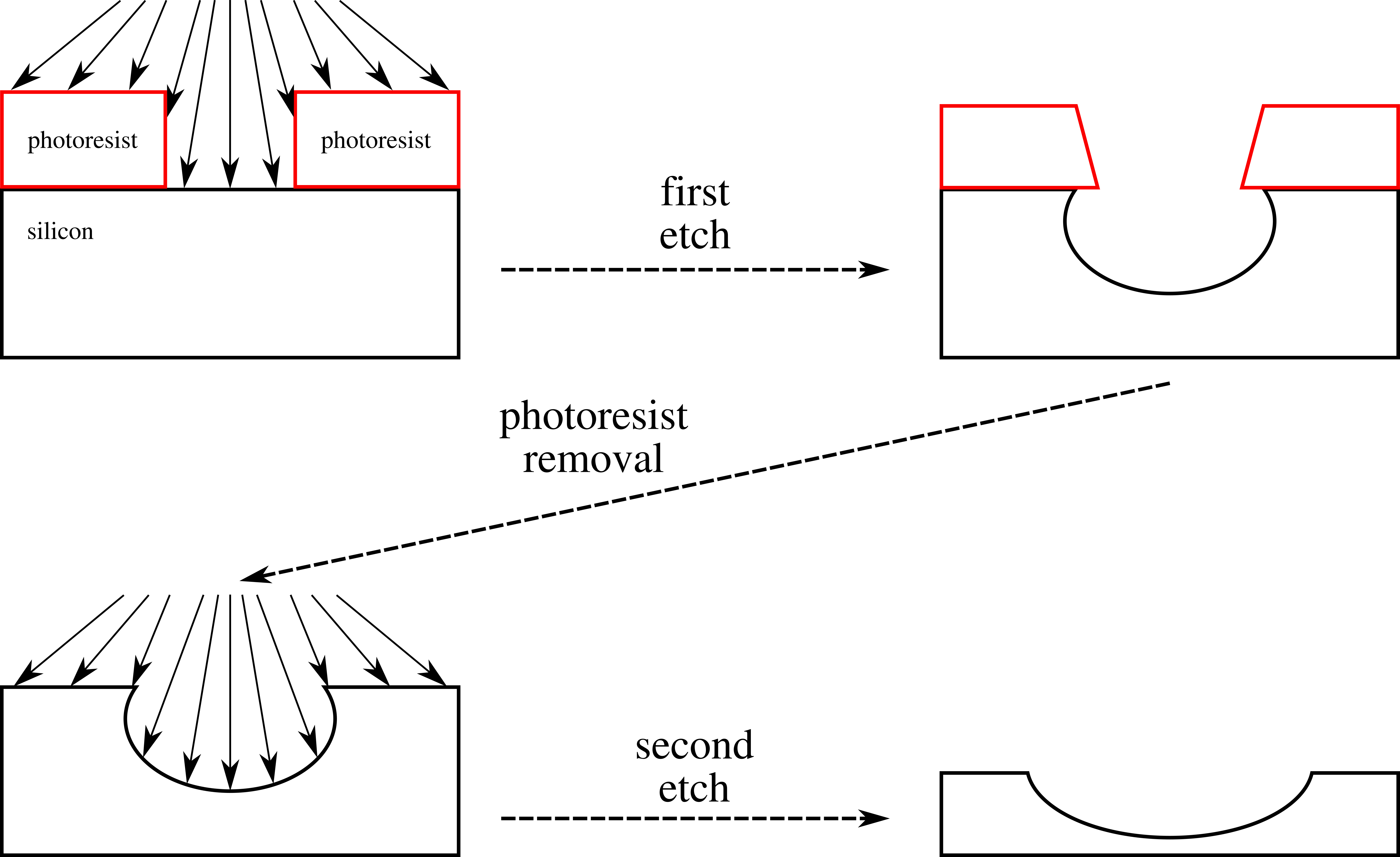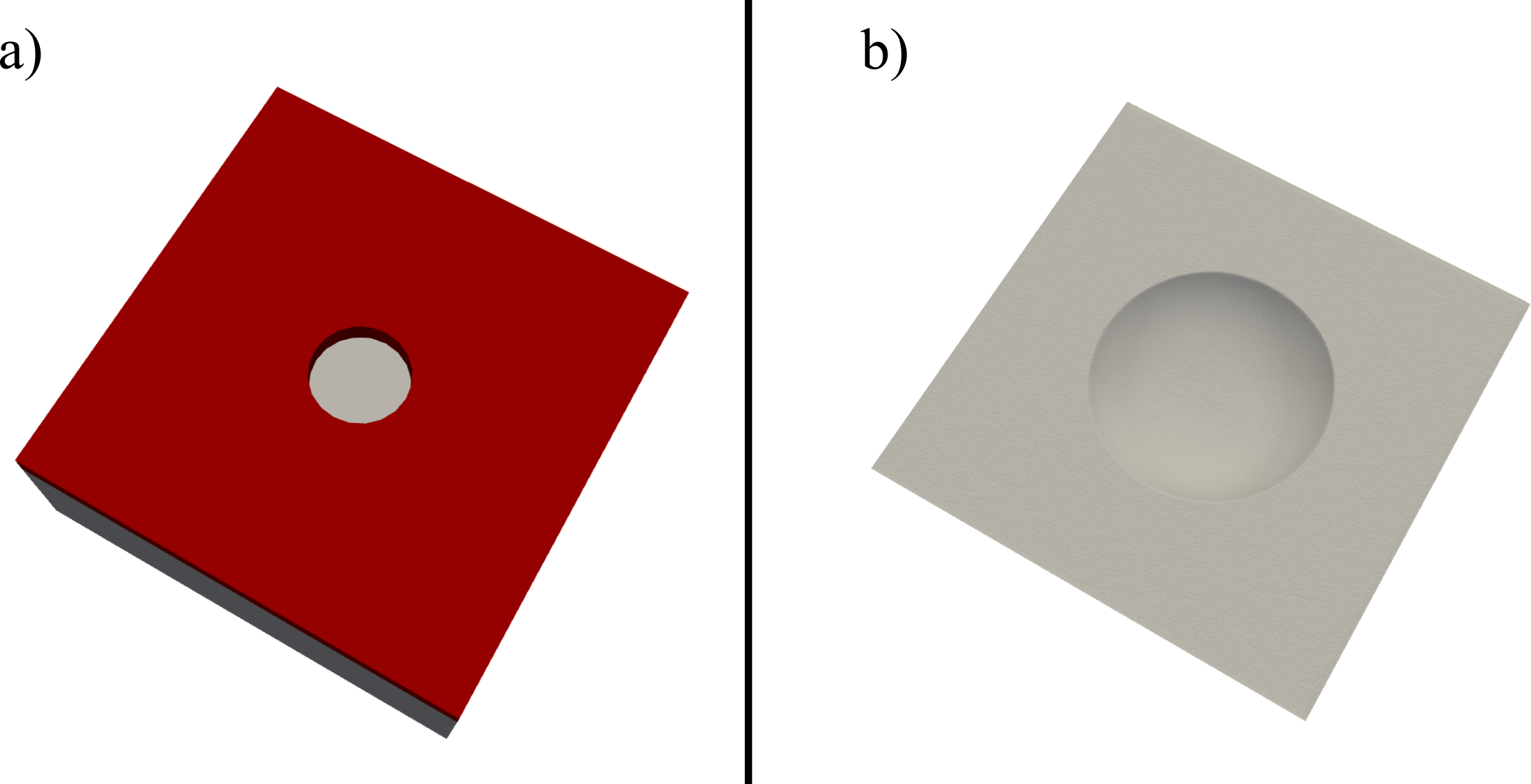Phenomenological Single-Particle
Modeling of Reactive Transport
in Semiconductor Processing
Chapter 6 Optimization of Silicon Microcavity Resonators
The final technical chapter of this thesis focuses on an application of topography simulation to the optimization of a fabrication process. As previously discussed in Chapter 5, the top-down
single-particle flux modeling approach with constant sticking coefficient
Optical resonators are a fundamental component of modern light-based devices with diverse applications [189]. The resonator quality strongly depends on the exact shape of the involved microcavities [187]. Therefore, their optimization requires achieving fine control over the geometry which subsequently involves a large effort in understanding their manufacturing. Conventionally, microcavities are manufactured in Si wafers using isotropic wet etching [190, 191]. More recently, low-bias SF6 plasma etching has been introduced as an alternative to this method due to its improved controllability, uniformity, and reproducibility [49]. Even though many advances have been made to reduce surface roughness [180] and improve mirror alignment [168], the challenge of precisely controlling the shape of the cavity still remains.
Topography simulation is an invaluable tool to tackle the issue of shape control. It is able to not only precisely reproduce the experimental geometries, but also enables a detailed investigation of alternative process recipes without having to perform multiple costly experiments. This chapter presents a simulation-driven optimization of the process parameters, namely the etch times, based on a robust calibration procedure. First, the fabrication and characterization of the experimental microcavity, performed by the collaboration partners, is briefly reviewed. Then, a robust novel calibration procedure is discussed, with particular focus on the critical feature detection algorithm. Finally, having obtained a calibrated simulation, the extraction and optimization of the microcavity parameters is presented.
Own contributions: The development of the custom feature detection algorithm, its integration with an automatic calibration procedure, and also the computational study of the optimization of optical and process parameters are novel contributions. These results have been originally published as a journal article [174].
6.1 Silicon Microcavity Resonators
Optical resonators are invaluable components with applications in diverse fields of science and technology. They enable a strong coupling between matter and light, thus finding use in, e.g., laser physics [192, 193], spectroscopy [194, 195], and in fundamental quantum science [196, 197]. There are several mirror configurations which enable optical resonators [168, 187], but in general they involve at least one cavity. For instance, a plano-concave (PC) resonator requires one cavity and one plane mirror, while a concave-concave (CC) configuration requires two cavities. In all cases, a very precise control of the shapes of the cavities is crucial, since geometric quantities, such as the radius of curvature (ROC), directly impact the quality metrics of the resonator [187].
Advanced micro- and nanomachining techniques of Si lend themselves to the development of very high quality optical resonators based on silicon microcavities. Since the desired structures have spherical or parabolic shapes, i.e., broadly isotropic shapes, the initial research efforts were driven by conventional isotropic wet etching of Si [190, 191]. However, as discussed in Chapter 5, low-bias plasma etching using SF6 gas can have several advantages regarding controllability, reproducibility, and uniformity [49]. In addition, as shown in Section 5.2, an ideally isotropic process can lead to perfectly flat regions which are detrimental to optical device performance, since in this case the ROC is infinite.
A two-step low-bias inductively couple plasma (ICP) etching of Si has thus been proposed by Larsen et al. as a dry alternative to wet etching configurations for silicon microlens mold fabrication [49]. This fabrication process is illustrated in Fig. 6.1. After cylindrical openings are lithographically patterned on the photoresist, a first etch step is performed. The photoresist is then removed, and a second etch step is executed. This second maskless step is proposed to improve the quality of the final structure, a claim which is evaluated in Section 6.4. One significant trade-off of this approach is the increase in surface roughness [179] which is typical of dry etching processes. However, this roughness can be mitigated by a series of oxidation and oxide removal steps [180]. Additionally, SF6 etching enables the use of deep reactive ion etching (DRIE) techniques to create alignment structures which are crucial to enable high quality CC resonators [168].
This two-step etching process is employed by the experimental collaboration partners from the University of Vienna and TU Wien, first described by Wachter et al. in [168]. A moderately doped,
The resist is then lithographically patterned with an array of
From the
Then, these measurements were processed and tilt-corrected using the open-source tool Gwyddion [198]. Both profilometer measurements are combined into a single coordinate list for each microcavity after matching the
cavity centers to the same
This physical simulation focuses on the most important aspects of the fabrication processes, namely the two etch steps. The simulation assumes as the starting point an ideal lithography process, illustrated in Fig. 6.2.a). The etch steps are both physically modeled with the top-down flux modeling approach, described in Section 2.3.3 and evaluated in
Section 5.2, while the photoresist removal is assumed to be ideal and, thus, performed geometrically. The final state of the surface after both etch steps is shown in Fig. 6.2.b).
The topography simulation attempts to follow the physical process as closely as possible. The initial state of the geometry is a photoresist including an ideal cylindrical hole and a thickness of

